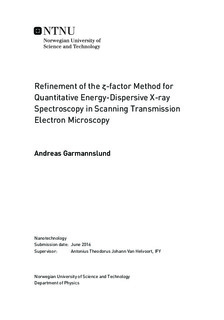Refinement of the ζ-factor Method for Quantitative Energy-Dispersive X-ray Spectroscopy in Scanning Transmission Electron Microscopy
Master thesis
Permanent lenke
http://hdl.handle.net/11250/2402186Utgivelsesdato
2016Metadata
Vis full innførselSamlinger
- Institutt for fysikk [2695]
Sammendrag
The ζ-factor method for quantitative energy-dispersive X-ray spectroscopy (EDS) has been implemented using the open source Python-based HyperSpy library. The ζ-factors for Ga, As, Al, C and Sb have been determined experimentally for a JEOL ARM200F with a JEOL Centurio silicon drift detector. Least-square fitting has been applied to estimate the ζ-factor for other elements. The ζ-factor method is refined by investigating orientation and tilt effects on the ζ-factors using GaAs nanowires as a model system. The most prominent effect is shadowing of X-rays from the specimen holder, carrier or grid, which leads to a higher ζ-factor being measured when the specimen is tilted away from the detector. Tilt series were taken from the GaAs core of a focused ion beam (FIB) cross section of an AlGaAs/GaAs core-shell nanowire in [111] and around two perpendicular axes of a the GaAs region of whole GaAs/GaAsSb axial-insert nanowires in [-110]. The ζ-factor allows for fitting shadowing models based on different detector geometries. For the used experimental set-up, shadowing does not occur (i.e. the active detector area and hence the signal is maximized) for specimen tilt (X-tilt) above 10° towards the detector. Quantitative compositional and thickness maps have been constructed using the refined ζ-factors for axial GaAs/GaAsSb and radial GaAs/AlGaAs nanowire heterostructures. The compositional maps were compared with maps constructed using the standard Cliff-Lorimer (CL) ratio technique, while thickness maps were compared with energy-filtered transmission electron microscopy (EFTEM) maps. Incorporating absorption corrections into the ζ-factor method gives only a small improvement in the accuracy of the quantification for the FIB made GaAs/AlGaAs and whole GaAs/GaAsSb nanowires. The refined ζ-factor method gives better results than the CL ratio technique in the regions of pure GaAs, while CL gives better results in the alloyed regions. This is believed to be due to uncertainties in the thickness determination used for calibrating the ζ-factors, especially for Al. Computational routines based on the ζ-factor method have been developed and made accessible for others. The routines can easily be adapted and applied to user-specific data sets as they are developed within an open source software platform.
